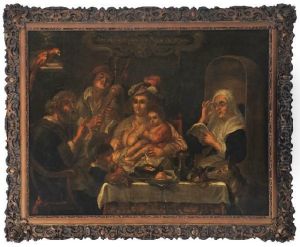Jakob Jordeans Paintings
Jacob Jordaens was a prominent Flemish painter of the 17th century, born on May 19, 1593, in Antwerp, Belgium. His work is often associated with that of Peter Paul Rubens and Anthony van Dyck, as the three artists represent the peak of Baroque painting in Flanders. Unlike his contemporaries, however, Jordaens did not spend a significant period in Italy, which was customary for artists of the time to complete their training. Instead, Jordaens' style was developed primarily in his native land, where he was influenced by the works of Rubens, whom he considered a mentor.
Jordaens' father was an affluent linen merchant, which allowed him to receive a good education and pursue an apprenticeship in the studio of Adam van Noort, who was also Rubens' teacher for a period. Jordaens married van Noort’s daughter, Catharina, in 1616, which further strengthened his ties to his teacher's artistic circle. His early works were deeply influenced by Rubens, with whom he collaborated on several occasions. After Rubens' death in 1640, Jordaens became one of the most sought-after artists in Flanders, taking over many of the commissions initially intended for his late mentor.
Throughout his career, Jordaens was known for his vibrant use of color and dynamic compositions. He worked on a variety of subjects, including mythological and religious scenes, portraits, and genre paintings depicting everyday life. One of his most famous works is 'The King Drinks,' a lively representation of the Twelfth Night feast, showcasing his skill in portraying group scenes brimming with energy and a touch of humor. Jordaens' religious works often conveyed a sense of warmth and humanity, making them accessible and relatable to viewers.
Later in his life, Jordaens' style underwent a transformation as he was influenced by the works of Caravaggio and his followers. His palette became more subdued, and his compositions gained a sense of introspection. Despite these changes, his paintings continued to be characterized by robust figures and a masterful rendering of textures and materials.
Jacob Jordaens passed away on October 18, 1678, in Antwerp. His legacy endured through his numerous paintings, many of which remain on display in museums worldwide. Jordaens is remembered not only as a master of the Flemish Baroque but also as an artist who brought a unique and personal interpretation to the grandiose and dramatic style of his era.
